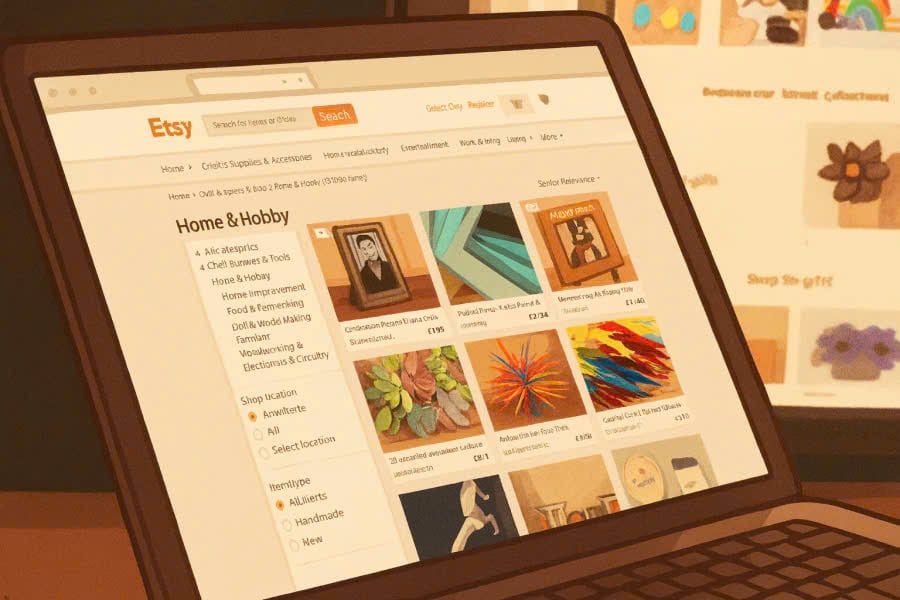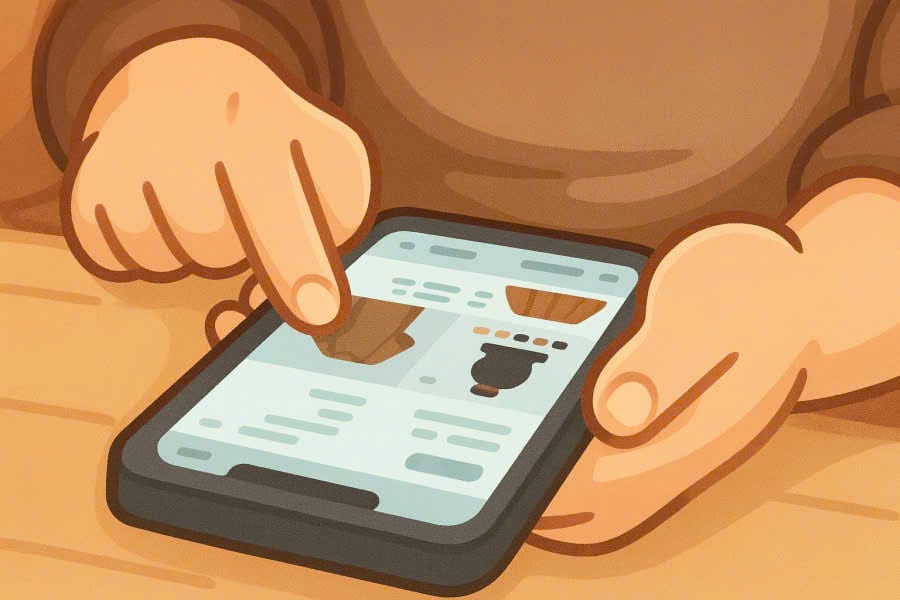
Wondering how much Etsy takes per sale? You’re not alone. Before you commit, it’s important to know how Etsy fees work and how they’ll affect your profits. Even small charges like a $0.20 listing fee or a 6.5% transaction fee add up fast.
In this guide, we’ll walk you through every Etsy seller fee one by one. From listing fees and payment processing fees to taxes and optional extras, you’ll see the real cost to sell on Etsy in 2025. Whether you’re offering handmade goods, vintage items, or print-on-demand products, this breakdown will help you price with confidence.
We’ll also share ways to reduce Etsy fees and show how Printeby’s Etsy integration helps you keep costs low while building a successful Etsy store.
Disclaimer
The information in this article is accurate as of the current date and may change. Consult Etsy’s website for the latest information. Please consult a professional advisor for any financial or legal guidance specific to your situation.
- Overview of Etsy’s Fee Model
Etsy is a marketplace primarily focused on handmade goods, personalized designs, print-on-demand products, accessories, and craft supplies. As an “online marketplace for creators,” Etsy allows sellers to reach a large international audience — but in exchange, sellers must pay several types of fees.
Like any commerce platform, Etsy operates on a clear business model — it earns revenue by charging sellers. On Etsy, these charges include:
- Fixed or recurring fees — such as listing fees or renewal fees
- Variable/percentage-based fees — applied when a sale occurs
- Optional or conditional fees — for example, advertising fees, currency-conversion charges, and off-site ad fees
To calculate your true profit, you need to understand every fee involved. Many new sellers only pay attention to the $0.20 listing fee, but the “hidden tail” behind it can easily eat into your profits if you don’t plan carefully.
Before diving into each fee type, note that Etsy fees may vary depending on your country of registration, shop currency, nationality, and location. The numbers below represent the most common rates across major markets — you should verify your country’s exact rates on Etsy’s official Fees & Payments Policy page.
2. Mandatory Fees in 2025
Below are the essential fees you’ll need to pay when selling on Etsy in 2025 — crucial for anyone who wants to operate seriously and understand their real costs.
2.1 Shop Setup Fee
In the past, Etsy did not charge any fee to open a shop, but there have been recent reports suggesting that some sellers are now being asked to pay a setup fee during the registration process.
(Source: The Busy Mom Side Hustle)
Some articles claim that the setup fee is around $15 USD for sellers in the United States.
(Source: The Busy Mom Side Hustle)
Other sources report a range of $15–29 USD, depending on the region.
(Source: LitCommerce)
However, Etsy has not officially announced a universal setup fee applicable to all sellers. It may only apply to new sellers in certain countries or as part of the account verification process.
Note: Before you start, check the shop registration screen on Etsy in your country to confirm whether this setup fee applies to you.
2.2 Listing Fee
This is the fee most sellers are already familiar with — it’s a fixed cost:
Each time you publish a new product listing, Etsy charges a $0.20 USD fee (20 cents) — regardless of whether the item sells or not.
(Sources: Etsy Help, Marmalead)
A listing remains active for four months. If your item doesn’t sell within that time and you want to keep it active, you’ll need to renew the listing by paying another $0.20 USD.
(Sources: Etsy Help, Marmalead)
If you enable auto-renew, Etsy will automatically renew the listing and deduct the $0.20 USD fee when it expires. Otherwise, you can manually renew it yourself.
(Sources: Etsy Help, Growing Your Craft)
For multi-quantity listings, you’ll be charged an extra $0.20 USD for every additional item sold beyond the first.
For example, if you list 5 identical products and sell 3, you’ll pay an extra 2 × $0.20 USD on top of the original $0.20 USD listing fee.
(Sources: Etsy Help, Growing Your Craft)
If it’s a private listing (created for a specific customer), you’ll only be charged the $0.20 USD fee when the customer makes the purchase, not at the time of creation.
(Source: Etsy Help)
Therefore, the listing fee is an unavoidable expense — you’ll pay it whether your product sells or not.

2.3 Transaction Fee
When you make a sale, Etsy charges a transaction fee as follows:
Currently, Etsy takes 6.5% (six and a half percent) of the total order value — which includes the product price, shipping fee, and any gift wrapping or additional content charges.
(Sources: Webretailer.com, Etsy Help)
Note: Etsy calculates this fee based on the total amount paid by the buyer (in your listing currency). If your order includes a shipping fee, Etsy still charges 6.5% on the shipping portion as well.
(Sources: Etsy Help, Marmalead)
This transaction fee only applies when a sale occurs — if your listing doesn’t sell, you won’t be charged this fee.
(Sources: Marmalead, Etsy Help)
On your Payment Account invoice, the transaction fee may appear as two separate lines:
- “Transaction fee (item)”
- “Transaction fee (shipping)”
if shipping charges are involved.
(Source: Craftybase)
Example:
If you sell an item for $20 USD and charge $5 USD for shipping, the total order value is $25 USD.
Etsy’s fee = 6.5% × 25 = $1.625 USD.
(Source: Craftybase)
2.4 Payment Processing Fee (Merchant Fee)
In addition to the transaction fee, if you use Etsy Payments (Etsy’s integrated payment system), you’ll also be charged a payment processing fee. This fee covers the cost of handling payment transactions — including credit cards, bank transfers, and integrated PayPal payments, among others.
(Sources: Etsy, Etsy Help, Marmalead)
For sellers in the United States, the processing fee is 3% + $0.25 USD of the total order amount (including both product price and shipping).
(Sources: Etsy Help, Marmalead, Webretailer.com)
In other countries, the percentage and fixed amount may vary — for example, 2.9% + $0.30 USD, or other rates depending on local market regulations. You should check the Etsy Payments policy for your specific country to confirm the exact rate.
(Sources: Etsy, Craftybase )
When you issue a refund, the payment processing fee is usually not returned to you — meaning Etsy may keep both the fixed amount and the percentage fee, even after you refund the buyer.
(Source: Webretailer.com)
If the buyer uses independent PayPal (in countries where Etsy Payments is not available), you may be charged a separate PayPal fee. However, when PayPal is integrated through Etsy Payments, there is no additional PayPal fee beyond the Etsy Payments charge.
(Source: Etsy)
2.6 Advertising Fees & Offsite Ads (Promoted Listings / External Ads)
This fee is optional — but it can become mandatory if your shop reaches a certain revenue threshold.
Promoted Listings (Etsy Onsite Ads):
If you run ads to boost your visibility within Etsy’s search results, you’ll pay according to a pay-per-click (PPC) model or based on the budget you set. You only pay when someone clicks on your ad.
(Sources: Webretailer.com, Marmalead)
Offsite Ads (External Advertising):
Etsy may promote your shop or products across external channels such as Google, Facebook, Instagram, and Pinterest.
- If your shop revenue is below $10,000 USD in the past 365 days, you can opt out of Offsite Ads participation.
(Sources: Webretailer.com, Wix.com, Marmalead) - If your shop revenue exceeds $10,000 USD per year, participation in Offsite Ads becomes mandatory, and you’ll be charged 12% of the total order value (including item price + shipping) for any sale that results from an Offsite Ad.
(Sources: Webretailer.com, Wix.com, Marmalead)
The Offsite Ad fee is applied to the total order amount (item price + shipping cost).
(Sources: Wix.com, Marmalead)
Etsy also sets a maximum limit of $100 USD per order for Offsite Ad fees — meaning the advertising charge will never exceed that cap.
(Source: Wix.com)

2.7 Auto-Renewal, Penalties & Other Miscellaneous Fees
In addition to the main fees mentioned above, there are several smaller or situational charges that sellers may encounter:
- Listing Renewal Fee:
If you have auto-renew enabled, when your 4-month listing period expires and the item hasn’t sold, Etsy will automatically renew it and charge $0.20 USD.
(Sources: Etsy Help, Marmalead) - Additional Listing Fees for Multi-Quantity Sales:
As mentioned earlier, if you sell multiple units from the same listing, you’ll be charged an extra $0.20 USD for each additional item sold (e.g., for the 2nd, 3rd item, etc.).
(Sources: Etsy Help, Marmalead) - Shipping Label Fee:
If you use Etsy Shipping Labels (Etsy’s integrated shipping service), you’ll pay the carrier’s shipping cost plus any service fee charged by Etsy.
(Sources: Etsy Help) - VAT / Tax Handling Fee:
If you operate in a region subject to VAT or service tax, Etsy may apply VAT to your seller fees accordingly.
(Sources: Etsy Help) - Listing Cancellation / Shop Suspension Penalties:
In cases where sellers violate Etsy’s policies, the platform may impose fines, cancel listings, or temporarily suspend your shop. These are exceptional situations that typically don’t occur if you comply with Etsy’s rules.
(Source: Etsy Help)
3. Example: Real Cost Breakdown
To help you visualize how Etsy’s fees add up, here are some practical scenarios based on hypothetical products and orders.
Example 1: Seller in the U.S. — Single Product Sale
| Item | Description | Amount |
|---|---|---|
| Product Price | $20.00 USD | |
| Shipping Fee (charged to buyer) | $5.00 USD | |
| Total Order Value | — | $25.00 USD |
Etsy Fees Applied
| Fee Type | Formula | Amount |
|---|---|---|
| Listing Fee | Fixed $0.20 USD | $0.20 USD |
| Transaction Fee (6.5%) | 6.5% × 25.00 | $1.625 USD |
| Payment Processing Fee (3% + $0.25) | (3% × 25.00) + 0.25 = 0.75 + 0.25 | $1.00 USD |
| Total Mandatory Fees | — | $2.825 USD |
Additional Costs (if applicable)
| Type | Formula / Example | Amount |
|---|---|---|
| Currency Conversion Fee | ~2.5% × 25.00 | ≈ $0.63 USD (if applicable) |
| Offsite Ads Fee | 12% × 25.00 | $3.00 USD (if the order came from Offsite Ads) |
With this order, if there are no Offsite Ads and no currency conversion fees, you’re paying $2.825 USD in total Etsy fees — that’s about 11.3% of your total revenue of $25.00 USD.
If you include the $0.63 USD currency conversion fee, the total comes to roughly $3.455 USD, or about 13.8%.
Example 2: Seller in Canada or Another Country
Example:
- Product price: 30.00 CAD
- Shipping fee: 7.00 CAD
- Total order value: 37.00 CAD
Etsy still charges the 6.5% transaction fee → 6.5% × 37.00 = 2.405 CAD.
Payment processing fees (depending on the country) may range from 3–4% + a fixed charge.
The listing fee of $0.20 USD also applies (converted to your local currency).
Overall, the total actual cost usually accounts for around 10–13% of your gross revenue.
Many reports estimate Etsy’s real take rate — after including ads and hidden costs — to be roughly 10–13%.
(Sources: Seller Journal, Marmalead)
Example 3: Order Generated Through Offsite Ads
If an order is generated via Offsite Ads (external advertising), Etsy charges an additional 12% fee (and sometimes up to 15%, depending on the campaign period).
(Sources: Marmalead, Wix.com, Craftybase)
Example:
- Order value: $25.00 USD
- Offsite Ads fee: 12% × 25.00 = $3.00 USD
When added to your base fees:
- 2.825 + 3.00 = $5.825 USD total, or roughly 23.3% of the order value.
This shows how Offsite Ads can significantly reduce your net profit margin.

4. Actual “Take Rate” & Market Comparison
The “take rate” refers to the percentage of each transaction that Etsy takes — essentially, the ratio of total fees to total revenue.
In theory, if you only count the transaction and listing fees, the take rate appears low.
However, in reality, once you add payment processing, ads, and currency conversion, the percentage rises significantly.
Many sources estimate that Etsy’s total cost per order (excluding Offsite Ads) typically falls around 9–10%, or 10–13% when including extra fees.
(Sources: PaymentCloud, Seller Journal, Marmalead)
When Offsite Ads are involved, the total take rate can reach 15–25%, depending on the size and value of the order.
(Sources: PaymentCloud, Craftybase)
Some reports suggest that even without external ads, you’ll lose about $0.45 + 9.5% of your revenue on a typical order.
(Source: PaymentCloud)
According to The Seller Journal, after all fees are factored in, Etsy’s total cost usually amounts to 10–13% of the selling price.
(Source: Seller Journal)
Comparison with Other Marketplaces
- Amazon (Marketplace / Handmade):
Typically charges a higher commission, often 15% or more. - Shopify:
You pay a monthly platform fee and payment processing fee, but no per-transaction commission if you’re already on a paid plan. - Print-on-demand platforms like Redbubble or Printful:
Their “fees” are often built into the product base cost, so they’re less transparent but still affect profit margins.
Bottom line:
If you plan to sell seriously on Etsy, you should budget at least 10–15% of your revenue as the portion Etsy will likely take from your profits.
5. Strategies & Tips to Reduce Etsy Fees Effectively
Knowing the fees is not enough — you need a clear strategy to maximize your profit margins. Below are practical tips and expert advice from experienced Etsy sellers.
5.1 Optimize Listings to Avoid Unnecessary Fees
- Turn off auto-renew for listings that have a low chance of selling; renew them manually only when needed.
- If an item hasn’t sold after 4 months, let it expire instead of paying another renewal fee.
- Only list multiple quantities (multi-quantity) when you’re confident they’ll sell, since each additional sale incurs an extra $0.20 fee.
- Bundle related products (e.g., create combo listings) to reduce the total number of listings you pay for.
5.2 Optimize Shipping & Shipping Fees
- Calculate your shipping price carefully, since Etsy charges 6.5% on shipping fees as well.
- Use cost-effective shipping options — if you use Etsy Shipping Labels, take advantage of any available discounts.
- For international sellers, compare cross-border shipping providers to find lower-cost options.
5.3 Manage Advertising Wisely & Control Offsite Ad Costs
- Use Promoted Listings only for your best-selling products with high conversion potential.
- Set reasonable ad budgets and test small campaigns before investing heavily.
- If your annual sales are below $10,000 USD, consider opting out of Offsite Ads to avoid the 12% fee.
- If your shop has surpassed the threshold, factor Offsite Ad costs into your product pricing, or promote items with higher profit margins.
- Always track your ROI (Return on Investment) — if ads cost more than the profit they bring, turn them off immediately.
5.4 Optimize Currency & Reduce Foreign Exchange Costs
- Use the same currency for your listings and your payout account (if supported in your country) to avoid the 2.5% conversion fee.
- When selling internationally, consider receiving payments in the currency most of your customers use — but remember you’ll pay conversion fees if it differs from your bank currency.
- Try to batch transactions or shipments to reduce multiple small currency conversions.
5.5 Control Refunds & Payment Processing Fees
- Reduce return rates by providing clear product descriptions, accurate photos, and excellent customer support.
- Remember: payment processing fees are often non-refundable, so ensure your return policy is clearly stated.
- Check whether your country offers a refund on processing fees — some regions allow partial reimbursement if the refund is full and valid.
5.6 Build Your Own Platform & Sell Multichannel
- If your sales are strong, consider building your own website (e.g., Shopify or WooCommerce) to reduce dependency on Etsy.
- For print-on-demand sellers, consider integrating with third-party providers (like Printeby) for production and shipping — you’ll only pay Etsy’s sales fees plus production and delivery costs.
- Sync inventory across all channels to avoid overlisting or paying for inactive listings.
5.7 Track Fees & Performance Regularly
- Use cost tracking tools (Excel, Google Sheets, or sales management software) to log all Etsy-related expenses.
- Compare your profit before and after fees — if margins are too thin, consider increasing your prices.
- Regularly check whether your shop has become subject to mandatory Offsite Ads (if you pass the $10,000 annual sales mark).
- Stay updated with Etsy’s changing policies — visit the official Fees & Payments Policy page periodically, as Etsy occasionally updates its fee structure.
(Source: Etsy)

6. Conclusion & Practical Advice
Quick Summary of Etsy Fees in 2025:
- Listing Fee: $0.20 USD per listing (for each new or renewed item)
- Transaction Fee: 6.5% of the total order value (including product price + shipping + gift wrap, if any)
- Payment Processing Fee (Etsy Payments): Around 3% + $0.25 USD (for U.S. sellers; rates vary by country)
- Currency Conversion Fee: Approximately 2.5% if your listing and payout account use different currencies
- Advertising Fees / Offsite Ads: 12% for shops with annual revenue over $10,000 USD, or PPC-based for on-platform ads
- Additional Fees: Renewal fees, extra listing fees (for multi-quantity sales), refund processing fees, and shipping label costs
When you combine everything, you can expect to lose about 10–13% of your typical revenue to Etsy’s fees.
If Offsite Ads are involved, the total cost can rise to 15–25% or more, depending on order size and category.
Practical Tips for Sellers:
- Always calculate your total costs before setting prices — don’t let Etsy’s fees quietly eat into your profits.
- Start with high-margin products so you can absorb the platform fees more comfortably.
- Monitor your advertising performance closely — turn off any campaigns that aren’t generating a positive return.
- Use smart currency management to reduce foreign exchange fees when selling internationally.
- Once your sales grow steadily, consider building your own website (e.g., on Shopify or WooCommerce) to reduce long-term platform dependency and operating costs.

Earn Profits on Etsy with Printeby – The Ultimate Solution for POD Sellers & Chibi Artists
Why Combine Etsy with Printeby?
If Etsy is the global marketplace, then Printeby is the automated production and fulfillment studio that lets you sell without touching the printing, packing, or shipping process.
With Printeby, all you need to do is upload your artwork to Etsy and sync your Print-On-Demand (POD) products — the system automatically prints, packs, and ships each order to your international customers.
“I just sell my ideas — Printeby handles the rest.”
How the Model Works
- Choose Your POD Products on Printeby
- Chibi T-shirts, hoodies, tumblers, notebooks, tote bags, canvas prints, etc.
- Browse the collection at Printeby Shop
- Upload Your Chibi or Artwork Designs
- Printeby supports both AI-generated art and original handmade illustrations.
- Every product is printed on demand, with no inventory required.
- List Your Products on Etsy in Just a Few Clicks
- Automatically sync products from Printeby to Etsy (via API or manual upload).
- When an Etsy order is placed → Printeby automatically prints, packs, and ships it worldwide.
- Earn the Profit Margin
- Profit = Selling Price on Etsy – (Printing Cost + Shipping Fee from Printeby).
- Example: T-shirt printing cost $12, selling at $25 → gross profit = $13.
- After Etsy fees (~$3, or 12%), you still make about $10 profit per shirt.
Real Example: Boosting Profits with Printeby + Etsy
| Product | Printing Cost (Printeby) | Suggested Etsy Price | Avg. Etsy Fees | Net Profit |
|---|---|---|---|---|
| Chibi Unisex T-shirt | $12.00 | $25.00 | ~$2.80 | $10.20 |
| Chibi Ceramic Mug | $9.00 | $22.00 | ~$2.20 | $10.80 |
| Chibi Notebook | $8.00 | $19.00 | ~$1.90 | $9.10 |
| Canvas Tote Bag | $11.00 | $26.00 | ~$2.90 | $12.10 |
With just 5–10 orders per day, you can easily earn $200–300/month — without ever handling a single product.
Benefits of the “Etsy x Printeby” Model
- No inventory needed – every product is printed only when ordered.
- No manual handling – Printeby automates global printing and shipping.
- Exclusive Chibi-style products – easy to go viral and sell well on Etsy.
- Copyright protection – every design includes metadata and traceable ownership.
- Fast integration with Shopify, WooCommerce, or Wix — so you can expand your sales channels easily.
Check Out Trending Products on Printeby
- Drink Cute Feel Cute Chibi Tumbler
- Oops Moment Whoa Cat Hardcover Journal
- Adventure In My Bag Canvas Tote
Strategy Tips: “How to Earn Real Profits” with Etsy + Printeby
- Pick a niche: Pet chibi, anime couples, professions (nurse, teacher, gamer, etc.)
- Create collections: Each niche should have 5–10 cohesive designs.
- Set competitive pricing with at least 40–50% margin to cover Etsy fees.
- Run light Etsy Ads ($2–5/day) to test high-converting listings.
- Boost traffic from social media (Pinterest, TikTok, Instagram).
- Upsell & cross-sell: When a buyer gets a shirt, suggest a matching mug, notebook, or tote.
Case Study – A Printeby Seller’s Success on Etsy
“I sold my first 20 chibi mugs in just 3 days on Etsy after connecting with Printeby.
Everything — from printing to delivery — was automated. I just created the designs.”
— Yumi K., Freelance Illustrator
Call to Action – Try Connecting Etsy & Printeby Today!
If you are:
- A Chibi artist who wants to turn your artwork into steady income,
- An Etsy shop owner looking for a reliable POD fulfillment partner,
- Or an entrepreneur wanting to sell cute anime-style gifts effortlessly —
Start now at https://printeby.com/ —
the most friendly, automated, and profitable Chibi POD platform of 2025.

Frequently Asked Questions (FAQ) – Etsy Fees & POD Selling 2025
❓ How much does Etsy take per order?
Etsy charges 6.5% transaction fee on the total order (product + shipping), plus about 3% + $0.25 USD payment processing, and a $0.20 listing fee.
Total costs usually account for 10–13% of your revenue.
❓ Does Etsy charge a monthly subscription?
No. Etsy doesn’t have a fixed monthly fee. You only pay when:
- You create or renew a listing ($0.20 every 4 months),
- You make a sale (fees are deducted automatically).
❓ Is Etsy free for new sellers?
Yes, partially. Etsy often offers 40 free listings when you open your shop through a referral link.
After that, each new listing costs $0.20 USD.
❓ How does Etsy charge for advertising?
Two types:
- Etsy Ads (Promoted Listings): You set your budget and only pay per click.
- Offsite Ads: Etsy advertises your products externally, and you pay 12% per order (mandatory if your annual revenue exceeds $10,000 USD).
❓ Can I avoid Etsy’s currency conversion fees?
Yes. Set your listing currency to match your payout currency.
If they differ, Etsy charges around 2.5% for conversion.
❓ How can I use Printeby with Etsy without losing profit?
- Set your prices 30–50% higher than Printeby’s base printing cost to offset Etsy fees.
- Use Printeby as your production and fulfillment partner — no inventory or manual handling.
- Focus on exclusive chibi designs to stand out from competitors.
Learn more at https://printeby.com/create-your-own/
❓ How do I calculate exact profit on Etsy?
Formula:
Profit = Etsy Selling Price – (Printeby Printing Cost + Total Etsy Fees + Ad Costs)
Example:
Sell a T-shirt for $25 USD
Printing cost: $12 USD + Etsy fees: $3 USD → Total cost = $15
Profit = $10 (≈ 40%)
❓ Can I connect Etsy with Shopify or WooCommerce?
Yes. If you want to scale beyond Etsy:
- Use Printcart or Printeby plugins to integrate with WooCommerce or Shopify.
- Keep Etsy as your main channel, and your website as an additional sales funnel.
Learn more at https://printeby.com/templates/
Final Thoughts
Etsy is a fantastic platform to start selling creative products — but to achieve consistent, scalable profits, you need to:
- Understand Etsy’s full fee structure (2025),
- Optimize pricing and ads,
- And integrate Printeby to automate production, shipping, and boost your margins.
“You sell your ideas — Printeby takes care of the rest.”
Start today at https://printeby.com
and turn your Etsy shop into a sustainable income machine in 2025.
